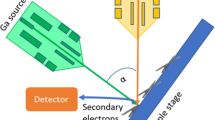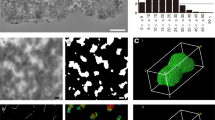Abstract
HeLa metaphase chromosomes were exammed by means of “in lens” field emission scanning electron microscopy, which permits high resolution detection of uncoated biological samples. By using uncoated chromosomes as a model for comparison we report evidence of how traditional scanning electron microscopy techniques such as metal coating and conductive methods can generate errors in chromosome structure evaluation, since both give rise to morphological artifacts. By comparing the morphology of uncoated chromosomes obtained by two different isolation procedures, such as that utilized in standard cytogenetics and the polyamine method, we have drawn the following conclusions: (a) the standard cytogenetic method gives rise to a chromosome structure consisting of a flattened network of 10 nm fibers, in which higher order chromatin organization is absent. (b) Chromosomes obtained by the polyamine method show both three-dimensional profile and higher level folding of chromatin fibers, supporting the loop chromosome organization previously suggested by scanning electron microscopy observation of hexylene glycol isolated chromosomes.
Similar content being viewed by others
References
Belmont AS, Sedat JW, Agard DA (1987) A three-dimensional approach to mitotic chromosome structure: evidence for a complex hierarchical organization. J Cell Biol 105:77–92
Brody TH (1974) Histories in cytological preparations. Exp Cell Res 85:255–263
Cocco L, Gilmour RS, Maraldi NM, Martelli AM, Papa S, Manzoli FA (1985) Increase of globin RNA synthesis induced by phosphatidylserine liposomes in isolated erythroleukemic cell nuclei. Morphological and functional features. Biol Cell 54:49–56
Cocco L, Papa S, Maraldi NM, Santi P, Martelli AM, Rizzoli R, Manzoli FA (1988) Chromatin structural transitions following histone H1 displacement by phosphatidylserine vesicles and low pH treatment. A multiparametric analysis involving flow cytometry, electron microscopy, and nuclease digestion. J Histochem Cytochem 36:65–71
Daskal Y, Mace JR ML, Wray W, Busch H (1976) Use of direct current sputtering for improved visualization of chromosome topology by scanning electron microscopy. Exp Cell Res 100:204–212
Harrison CJ, Britch M, Allen TD, Harris R (1981) Scanning electron microscopy of the G-banded human karyotype. Exp Cell Res 134:141–153
Harrison CJ, Allen TD, Britch M, Harris R (1982) High-resolution scanning electron microscopy of human metaphase chromosomes. Cell Sci 56:409–422
Hermann R, Muller M (1992) Towards high resolution SEM of biological objects. Arch Histol Cytol 55:17–25
Kelley RO, Dekker RAF, Bluemink JG (1975) Thiocarbohydrazide-mediated osmium binding: a technique for protecting soft biological specimens in the scanning electron microscope. In: Hayat MA (ed) Principles and techniques of scanning electron microscopy 4. Van Nostrand Reinhold Company, New York and London, pp 34–44
Klingholz R, Stratling WA, Shafer H (1981) Structure of rat liver nuclei after depletion and reassociation of histone H1 Exp Cell Res 132:399–407
Marsden MPF, Laemmli UK (1979) Metaphase chromosome structure: evidence for a radial loop model. Cell 17:849–858
Misell DL (1978) Image analysis, enhancement and interpretation. In: Glauert AM (ed) Practical methods in electron microscopy 7. North-Holland Publishing Company, Amsterdam, New York Oxford, pp 16–18
Murphy JA (1980) Non-coating techniques to render biological specimens conductive/1980 update Scanning Electron Microcs 1:209–220
Naguro T, Inaga S, Iino A (1990) The tannin-osmium conductive staining after dehydration: an attempt to observe the chromosome structure by SEM without metal coating. J Electron Microsc 39:511–513
Sumner AT (1991) Scanning electron microscopy of mammalian chromosomes from prophase to telophase. Chromosoma 100:410–418
Sumner AT, Ross A (1989) Factor affecting preparation of chromosomes for scanning electron microscopy using osmium impregnation. Scanning Microsc [Suppl] 3:87–99
Sumner AT, Evans HJ, Buckland RA (1973) Mechanisms involved in the banding of chromosomes with quinacrine and Giemsa. I. The effects of fixation in methanol-acetic acid. Exp Cell Res 81:214–222
Takayama S, Hiramatsu H (1993) Scanning electron microscopy of the centromeric region of L-cell chromosomes after treatment with Hoechst 33258 combined with 5-bromodeoxyuridine. Chromosoma 102:227–232
Thoma F, Koller T, Klug A (1979) Involvement of histone H1 in the organization of nucleosome and of the salt-dependent superstructure of chromatin. J Cell Biol 83:403–410
Watt JL, Stephen GS (1986) Lymphocyte culture for chromosome analysis. In: Rooney DE, Czepulkowski BH (eds) Human cytogenetics. A practical approach. IRL Press, Oxford, England, pp 39–55
Author information
Authors and Affiliations
Rights and permissions
About this article
Cite this article
Rizzoli, R., Rizzi, E., Falconi, M. et al. High resolution detection of uncoated metaphase chromosomes by means of field emission scanning electron microscopy. Chromosoma 103, 393–400 (1994). https://doi.org/10.1007/BF00362283
Received:
Revised:
Accepted:
Issue Date:
DOI: https://doi.org/10.1007/BF00362283




